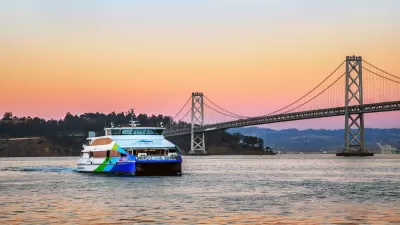After 25 years, Santa Clara's light rail has failed to live up to its promise, proving to be “among the least successful in the nation” reports Mike Rosenberg, while “serving as a constant reminder that the car is still king in Silicon Valley."
Despite expanding out over a stretch of 42.2 miles, with 62 stations, and serving 32,000 one-way commuters, Silicon Valley's VTA system is still considered to be one of the most costly, slow, inefficient and under-utilized in the nation, writes . It cost $2 billion to build and costs $66 million a year to operate. Each vehicle costs 30 percent more than the national average to operate and carries 30 percent fewer passengers. And the system is heavily subsidized by taxpayers, at the second worst rate in the nation. Critics see it as an innately flawed failure, yet advocates point to decreased freeway traffic while remaining optimistic that usage will increase in years to come.
VTA transportation manager Kevin Connolly contrasts its failures with San Francisco's successes, “[i]n our case we tried to graft a big-city transit type of mode onto a suburban environment, and it's still kind of a work in progress." Routes were planned along onion fields, rather than along existing, dense corridors, and “the density never materialized in Silicon Valley,” notes Rosenberg.
Those who remain optimistic acknowledge there is much improvement to be made. "In general, we can't lose sight of the fact that we have to do the basics better," says Connolly. "We have to be faster, we have to connect with better destinations." Proposals in the pipeline include adding more tracks for express trains, as well as reductions in service costs, which could lead to more funding.
FULL STORY: 25 years later, VTA light rail among the nation's worst

Alabama: Trump Terminates Settlements for Black Communities Harmed By Raw Sewage
Trump deemed the landmark civil rights agreement “illegal DEI and environmental justice policy.”

Planetizen Federal Action Tracker
A weekly monitor of how Trump’s orders and actions are impacting planners and planning in America.

The 120 Year Old Tiny Home Villages That Sheltered San Francisco’s Earthquake Refugees
More than a century ago, San Francisco mobilized to house thousands of residents displaced by the 1906 earthquake. Could their strategy offer a model for the present?

In Both Crashes and Crime, Public Transportation is Far Safer than Driving
Contrary to popular assumptions, public transportation has far lower crash and crime rates than automobile travel. For safer communities, improve and encourage transit travel.

Report: Zoning Reforms Should Complement Nashville’s Ambitious Transit Plan
Without reform, restrictive zoning codes will limit the impact of the city’s planned transit expansion and could exclude some of the residents who depend on transit the most.

Judge Orders Release of Frozen IRA, IIJA Funding
The decision is a victory for environmental groups who charged that freezing funds for critical infrastructure and disaster response programs caused “real and irreparable harm” to communities.
Urban Design for Planners 1: Software Tools
This six-course series explores essential urban design concepts using open source software and equips planners with the tools they need to participate fully in the urban design process.
Planning for Universal Design
Learn the tools for implementing Universal Design in planning regulations.
Clanton & Associates, Inc.
Jessamine County Fiscal Court
Institute for Housing and Urban Development Studies (IHS)
City of Grandview
Harvard GSD Executive Education
Toledo-Lucas County Plan Commissions
Salt Lake City
NYU Wagner Graduate School of Public Service





























